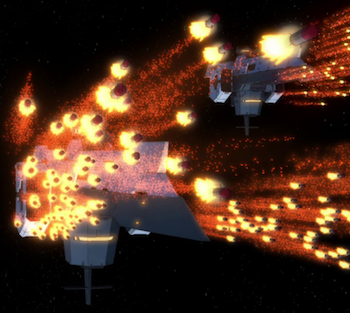My solution for the question is to rule that if players want their ships to look like something out of a
Star Munchkin cartoon, that's fine; just say that their 57 assorted laser cannons are, for game convenience, treated as equivalent to a triple laser turret.
- - -
Epicenter said:
. . .
(For the record, I think that starship combat in every RPG I've ever seen is fundamentally flawed at a meta level as they're prone to results which cut off avenues of RP instead of creating them; "players in most RPGs cannot "saveload" if their ship gets blown up vs. if there's no true threat to the players combat isn't any fun" so take my observations with a grain of salt.)
I agree with this basic point: in space combat, you have a choice between realism – just about everything at space velocity is a one-shot kill – and playability – it's more fun to fight it out and wear each other down, with the player characters winning some of the time, escaping with battle damage some of the time, and occasionally ending up in an adventure to escape from a prisoner-of-war planet.
Some of the physics-minded people on the
GURPS Traveller bulletin board worked out the damage from a single missile based on its kinetic energy, and concluded that they're almost always better off getting rid of the entire explosive warhead in favor of more kinetic energy – and that at longer ranges just about any missile that gets through point defense will take out any ship (even up to a million dtons) with a single shot, unless its entire path passes through cargo hold. This happened in a play-test, and as a result they ruled that any kinetic energy beyond three turns of acceleration (such as from a custom high-endurance missile) would be lost to blow-through.
I recall a play-test I did of a
Star Trek role-playing game based on the
Star Fleet Battles license (which the owners of
Trek granted before they realized that
Trek would be such an enduring property). In that game, a phaser set to "stun" had about as much chance of knocking someone out as a single punch, and a phaser set to "kill" was about as deadly as a knife – in other words, a "stun" could knock someone out in one shot, and "kill" could kill in one shot, but they usually didn't. But the game's phaser wasn't as good at stunning as a Taser, and wasn't as good at killing as a sword or a pistol. My play-test comments amount to the idea that in
Trek, a phaser set to "kill" would kill a red-shirt in the first act of the show, and would always miss a cast regular, and a phaser set to "stun" would always stun if it hit, but whether it hit or not depended on whether someone needed to be knocked out by the next scene – and that's why the show had so many fist fights than firefights, and why no one ever wore armor.
That's a recurring issue with science fiction: reasonably plausible science fiction weapons either miss or kill (or miss or stun if they're meant to be non-lethal) – but that's not fun, so scripted fiction or game rules have to depart from plausibility for the sake of drama or fun.

